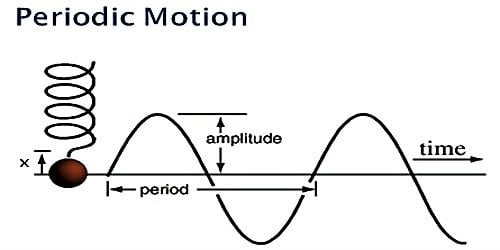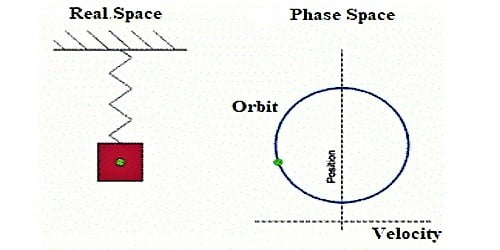Periodic Motion: Any motion that repeats itself after regular intervals of time is known as periodic motion. Any motion that repeats itself at a normal interval of time is called periodic motion. Examples: Motion of the pendulum of a clock, the motion of planets around the Sun, etc. A motion which repeats itself in equal intervals of time is periodic. The examples of periodic motion are the motion of planets around the Sun, motion of hands of a clock, motion of the balance wheel of a watch, motion of Halley’s comet around the Sun observable on the Earth once in 76 years.
Periodic motions can be classified into two major categories. First one is normal periodic motions, which happen in nature without any outside force; the second type is non-natural or man-made periodic motions. These motions are forced periodic motions such as diesel engines.

Oscillatory Motion: If a body moves back and forth repeatedly about a mean position, it is said to possess oscillatory motion. When a body moves in to and fro motion over and over again about a fixed point, then its motion is called oscillatory motion. For Example The mean of the pendulum of a clock; Motion of a loaded spring etc.
Vibrations of guitar strings, the motion of a pendulum bob, vibrations of a tuning fork, and oscillations of the mass suspended from a spring, vibrations of the diaphragm in telephones and speaker system and freely suspended springs are few examples of oscillatory motion. In all the above cases of vibrations of bodies, the path of vibration is always directed towards the mean or equilibrium position.
There are three types of oscillatory motions. The first type is the un-damped oscillatory motions in which the internal energy of the oscillatory motion remains constant. The second type of oscillatory motions is the damped oscillatory motions. In the case of damped oscillatory motions, the internal energy of the oscillatory motion decreases over time. The third type is the forced oscillatory motions. In forced oscillatory motions, a force is applied on the pendulum in a periodic variation to the pendulum.
All oscillatory motions are periodic but NOT all periodic motions are oscillatory. For example, the motion of a planet around the Sun is periodic but not oscillatory.

Similarities and dissimilarities –
- Periodic motion can be any motion after a certain period that the motion of the previous period repeats. Oscillatory motion is a repetitive motion between two or more states.
- Oscillatory motions are a type of periodic motion.
- Oscillatory motions are well defined for damped oscillations, simple harmonic oscillations, and for forced oscillations. Periodic motions, in general, are not well defined.
- Periodic motions are abundant in nature, but oscillatory motions are somewhat rare.
- Oscillatory motions can be represented in other forms of periodic motions.
- Periodic motion is regular and the same for each period; oscillatory motion can change—it can damp out, or increase in amplitude and period.
- Oscillatory motion is a to and fro motion about a mean position and periodic motion repeat at regular intervals of time.
Oscillatory motions are motions where a symmetry point exists. Periodic motions are motions that repeat itself over time. Both of these motion types are broadly applicable in fields like astronomy, cosmology, satellite equipment, clock mechanized, planetary motion, automobile engineering, machines, and various other fields.












